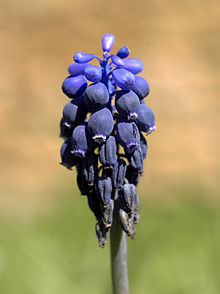Muscari neglectum
| Grape hyacinth | |
|---|---|

| |
| Scientific classification | |
| Kingdom: | Plantae |
| Clade: | Tracheophytes |
| Clade: | Angiosperms |
| Clade: | Monocots |
| Order: | Asparagales |
| Family: | Asparagaceae |
| Subfamily: | Scilloideae |
| Genus: | Muscari |
| Species: | M. neglectum
|
| Binomial name | |
| Muscari neglectum | |
| Synonyms | |
| |
Muscari neglectum is a perennial bulbous plant, one of a number of species and genera known as grape hyacinth and in particular common grape hyacinth[1] or starch grape hyacinth.[2] Muscari are perennial bulbous plants native to Eurasia. They produce spikes of dense, commonly blue, urn-shaped flowers. It is sometimes grown as an ornamental plant, for example, in temperate climates as a spring bulb.
Description
Muscari neglectum is a herbaceous plant growing from a bulb. The flower stems are 5–20 cm tall. The flowers are arranged in a spike or raceme and are dark blue with white lobes at their tips (teeth); there may be a cluster of paler sterile flowers at the top of the spike.[3] The raceme is 2–6 cm long. The fruit is a 3-celled capsule with two ovules in each cell.[4]
It is a very well known species in cultivation (being described as the "common" Grape Hyacinth by Mathew); it increases rapidly and can become invasive.
Taxonomy
The name was attributed to Giovanni Gussone by Michele Tenore in a list of plants of the Neapolitan area published in 1842. The species has a confused nomenclatural history; no fewer than 46 full species names are listed as synonyms in the Kew World Checklist of Selected Plant Families.[5] The name M. racemosum is commonly found as a synonym for M. neglectum in the horticultural literature,[6] although the true M. racemosum Mill. is a different species.[5]
References
- ^ Grey-Wilson, Christopher; Mathew, Brian; Blamey, Marjorie (1981), Bulbs : the bulbous plants of Europe and their allies, London: Collins, ISBN 978-0-00-219211-8
{{citation}}: Unknown parameter|lastauthoramp=ignored (|name-list-style=suggested) (help), p. 114 - ^ USDA, NRCS (n.d.). "Muscari neglectum". The PLANTS Database (plants.usda.gov). Greensboro, North Carolina: National Plant Data Team. Retrieved 15 July 2015.
- ^ Mathew, Brian (1987), The Smaller Bulbs, London: B.T. Batsford, ISBN 978-0-7134-4922-8, p. 127
- ^ Cullen, James; Knees, Sabina G.; Cubey, H. Suzanne (2011). The European Garden Flora Flowering Plants: A Manual for the Identification of Plants Cultivated in Europe, Both Out-of-Doors and Under Glass. The Cambridge University Press. p. 124. ISBN 0521761476.
- ^ a b WCSP (2011), World Checklist of Selected Plant Families, The Board of Trustees of the Royal Botanic Gardens, Kew, retrieved 2011-11-14, search for "Muscari neglectum" Cite error: The named reference "KewWC_Mn" was defined multiple times with different content (see the help page).
- ^ See, e.g., Mathew 1987, p. 127
